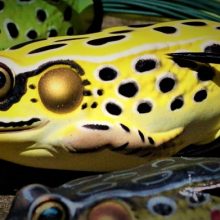This article may contain affiliate links. If you make a purchase after clicking on a link we may earn a small commission at no extra cost to you. As an Amazon Associate, I earn from qualifying purchases.
Best Frog Rod Setup for Bass

Using topwater frogs is one of the most fun and engaging ways to catch bass. If you have ever thrown a frog lure around thick weed cover or through a bed of lilies you know that pin point accuracy is a must.
Bass will absolutely smash both hard and soft bodied frog lures especially when they are actively feed in summer months.
Frogs do not like swimming in open water as they prefer to use vegetation as much as possible to camouflage themselves out of site from predators like musky or bass.
Because you will be working your lures through thick weeds you need a rod and reel that is up to the job.
The best frog rods will usually have a lot of backbone and will be considerably beefier than most other types of bass setups.
Frog Rod Setup
A good frog fishing setup means matching rod, reel and line to the size of lure you are looking to use.
You will need a combo that can handle large lures and heavy braid without sacrificing on casting performance and accuracy.
A light spinning setup would in no way be up to the job of working lures through thick cover. They quite literally do not have enough backbone to handle this style of fishing.
A baitcaster reel and a casting rod combined with braided fishing line is the usually configuration that the majority of anglers will use.
Rod
Chances are you will need to buy a dedicated rod but it can also be used for other setups like big swimbaits. If you do have a rod that you are already using for heavy flipping it can also be a great option.
Look for a rod that has roughly the following specifications:
- Power – Heavy power rating
- Length – Ideally between 7 and 8 feet
- Action – Fast to extra fast
Power – A heavy power rating is almost a must for big topwater lures like frogs. You will be running some heavy braid and using lures that create a lot of drag as they are retrieved through the water.
They will also be getting snagged regularly even if you are using weedless frog lures. Have a rod that has enough power in the blank to stand up to this kind of abuse is critical.
A lighter casting rig or spinning combo really is just not suitable for this style of fishing.
Length – Shoot for a rod between 7 and 8 feet in length. The shorter rod will be better if you are working lures in tight areas like in and around docks or up close to other structures.
A longer rod will cast a bit better and can also give you a bit more leverage when trying to steer bass away from an possible snags that might be close by.
Action – When we say that a rod has a particular action it usually means where exactly on the rod blank does the bend start to form once a load has been applied to it.
A fast action means that the rod will start to bend higher up through the rod towards the tip, usually in the top one third of the blank.
Reel
A baitcaster is the number one choice of reel when casting larger lures. A spinning reel is a lot more work when you are trying to make repeated casts in and around weed beds.
Bass love to wait in ambush and when one strike you need a reel that can handle a 5 lb bass that suddenly turns it’s nose straight for the weeds.
If you were to use a spinning reel it would need to be fairly large and the problem with that is that they would be considerably heavier than the equivalent modern light weight baitcaster.
Have full control of your line via thumb control on the reel spool as the lure is in the air is one of the major advantages of a casting reel over a spinning one.
Gear ratio is super important. Look for a baitcaster with a high gear ratio. You’ll need to be able to work the frog quickly over weeds and you’ll also need to be able to steer that bass away from cover as quickly as possible.
Line
Braided fishing line is without doubt the choice of line. Look to spool your reel with 50 pound braid at a minimum.
Braid has a massive advantage over monofilament in that it stretches less and it also has a smaller diameter than the same breaking strain of mono.
Low stretch means you can quickly set the hook. The lower diameter means that it will actually slice through weed and even lilies much easier than mono or flouro.
